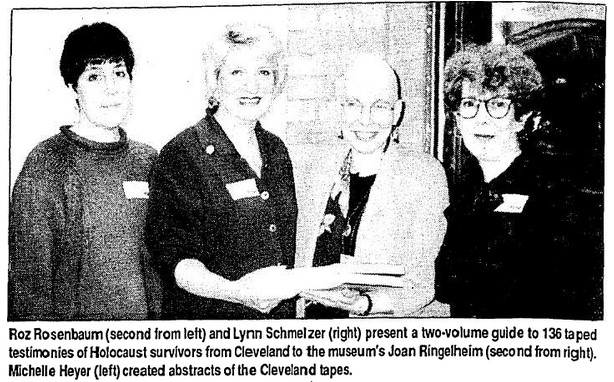|
Cleveland Jewish News Nov 19, 1993 page 16

NCJW Cleveland videotapes to
U.S. Holocaust Museum
CAROL K. ABRAMS Freelance Writer
Dedicated
NCJW members and community volunteers made the dream reality.
A week ago Wednesday, 50
Clevelanders rose early to board a morning flight from Hopkins
Airport to Washington, D.C, to complete a journey begun more than
ten years ago. In late 1982-early 1983, Cleveland Jewish News editor
Cynthia Dettelbach approached National Council of Jewish Women
(NCJW), Cleveland Section, with an idea. She had recently learned of
a project in New Haven, Conn., in which Holocaust survivors'
testimonies were being recorded on videotape and preserved in an
archive at Yale University. She hoped that NCJW, with its long and
distinguished history of innovative volunteer community projects,
would take on the monumental task of recording as much personal
Holocaust history in the Greater Cleveland area as possible, with
duplicates of the tapes to be added to the Yale collection.
Two-and-a-half years and more than 4,000 volunteer hours later, a
team of extraordinarily dedicated NCJW members and community
volunteers made the dream reality. The NCJW Holocaust Archive
Project produced 136 videotaped testimonies of Cleveland area
survivors, Righteous Gentiles, and liberators.
Three-hour interviews were conducted by trained volunteers at
WEWS-TV. "Everyone at Channel 5 became as involved and committed as
the rest of us were," recalled Bea Eisenberg, past president of
NCJW. "They all said it changed their lives forever." The station
later produced "A Time to Remember," an award-winning half-hour
documentary narrated by actor and survivor Robert Clary, created
from excerpts from the hundreds of hours of NCJW tapes. Master
copies of the tapes are housed at the Jewish Archives at Western
Reserve Historical Society Library, the Video Archive at Yale, and -
the reason for the Nov. 10th trip - the U.S. Holocaust Memorial
Museum in Washington, D.C. The NCJW contingent, chaired by Pauline
Leber, flew to Washington to present the tapes to museum officials
in the Oral History Archives. First, however, we had a four-hour
tour of the museum. In the group were former NCJW president, Lynn
Schmelzer; current president, Roz Rosenbaum; her husband, Harvey;
daughter-inlaw, Hilary, president of the Young Council Associates
group; Amy Budish, NCJW vice president of program/education; and
Rabbis Benjamin Kamin and Rosette Haim of The Temple. Joining men
and women ranging in age from 20 to 80-plus were Sammy Moshenberg,
NCJW's national representative in Washington, and Julie Snider,
representing Congressman Louis Stokes' office.
One of the workers most deeply involved in the
project, Michelle Heyer, was on hand. For six years she worked on
creating abstracts of one-third of the tapes, extracting information
from the vast amount of material so that it could be catalogued,
referenced and cross-referenced and become accessible to
researchers. "Michelle went everywhere with headphones on, listening
to the tapes," noted Schmelzer. She worked on this project during
summers, travel, living in Europe, getting her graduate degree from
Duke, and now in law school at Case Western Reserve University! She
is wholly responsible for the Resource Guide."
Two fat volumes of this guide, plus a copy of the WEWS documentary,
"A Time To Remember," were what Schmelzer presented to Joan
Ringelheim, head of the oral history department of the museum's
Research Institute. The actual copies of the 136 Cleveland tapes
will follow as soon as the museum is prepared to receive them.'
Ringelheim, elated at the acquisition, said the Cleveland collection
will add 10% to their current collection of 1,500 videotaped
testimonies. "Part of the museum's central mission is the gathering
of evidence," she said. "The basic information on the Cleveland
tapes will be put on computer and be accessible throughout the
world."
"Over 200,000 individuals have made contributions to the ($148
million) museum, with 60-70 gifts of over $1 million each, something
unheard of," noted Wesley Fisher, assistant director of the Research
Institute. "The majority of our visitors, 62%, are not Jewish, and
approximately 1% of the American Jewish community comes through the
museum each month." Roz Rosenbaum was understandably thrilled with
the day, "a historic one for NCJW," and the immediate sellout
response when the trip was announced. According to NCJW executive
director, Jean Heflich, the section is exploring a second plane trip
and tour of the museum in April 1994.
|